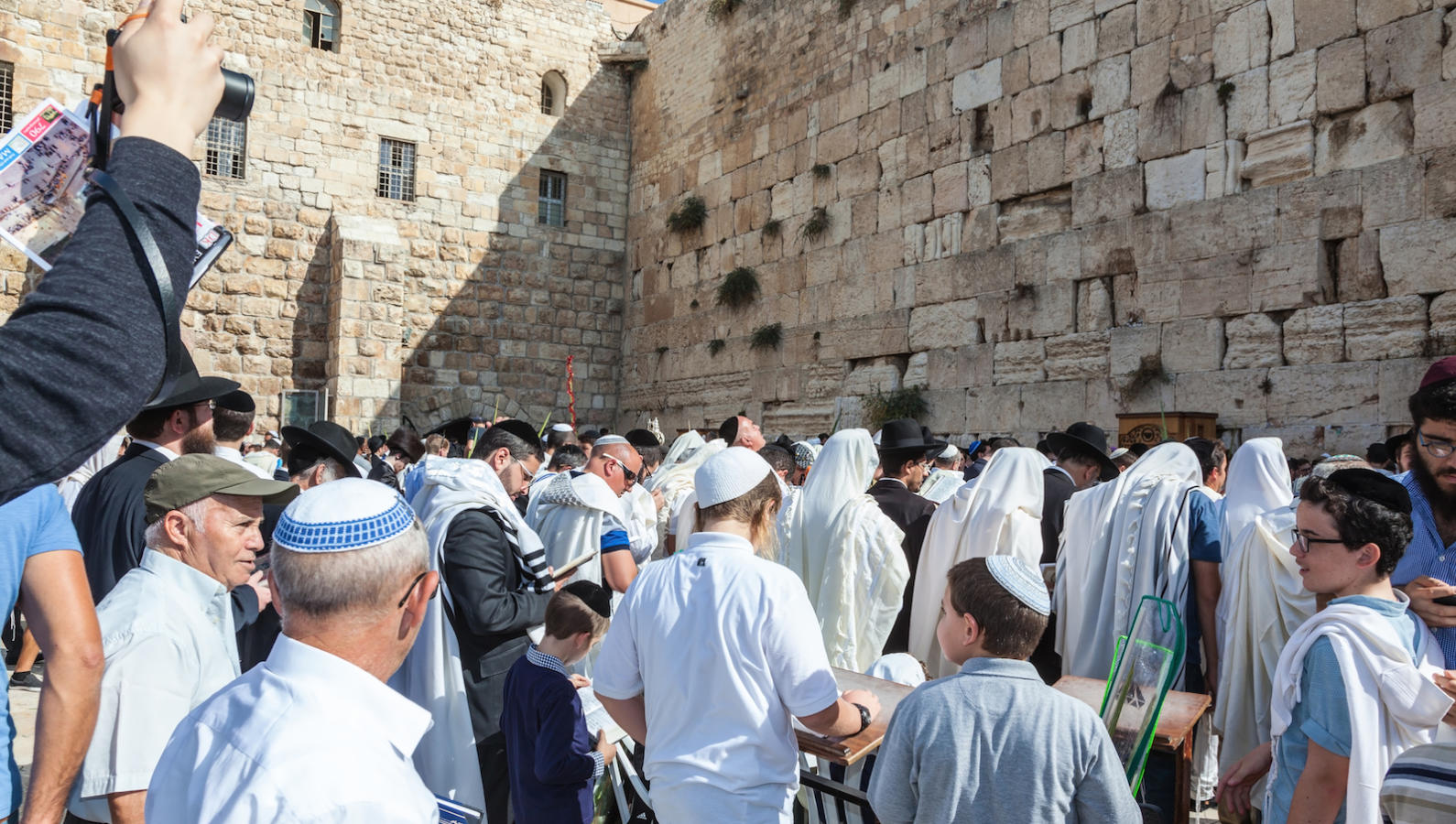In the Torah, major Jewish holidays are shorter than what most traditional Jews outside Israel celebrate now. So we read, “Seven days you shall eat unleavened bread” (Exodus 12:15) and celebrate eight days of Passover. The festivals of Shavuot, Yom Kippur, Rosh Hashanah, and Shemini Atzeret are listed as single days in the Torah.
How did Diaspora practice diverge from the Torah’s instructions? The answer lies in our history, during the time of transition from biblical to rabbinic Judaism around the beginning of the common era.
Addressing Confusion Over the Start of the New Month
The Jewish calendar is lunar. Over 2,000 years ago, a council of rabbis from the Sanhedrin, the ancient legislative and judicial body, held special sessions in Jerusalem at the end of each lunar month to receive witnesses to the first sliver of the new moon. Because a lunar cycle is approximately 29 days long, it was no mystery when the new moon should appear, but the Sanhedrin still declared months and holidays only on the basis of these witnesses. To encourage ordinary people to take the time to come and testify, the witnesses were fed and honored. The rabbis questioned every witness for credibility:
Where did you see [the new moon]? Was it before or after sunset? Was it in the north or the south? How high was it? How high was it? Which way was it tilted? (Mishnah Rosh Hashanah 2:6).
Once the sighting was legitimated, the rabbis declared the next day Rosh Hodesh, the beginning of the new month. Originally, beacon fires would be set on mountaintops to spread the word to distant Jewish communities already living in far away places such as Egypt and Babylon. Watchers on faraway hills set their beacon fires as soon as they saw them, continuing the relay “until one could behold the whole of the Diaspora before him like a mass of fire” (Mishnah Rosh Hashanah 2:4).
With your help, My Jewish Learning can provide endless opportunities for learning, connection and discovery.
But relations with neighboring sects such as the Samaritans worsened, and they deliberately harassed the Jews by lighting beacon fires at erroneous times. As a result, the Sanhedrin substituted messengers to alert the Diaspora communities, but they could take a long time to arrive from Jerusalem.
Only the Sanhedrin was able to make pronouncements about the new moon, so Diaspora communities could not do this for themselves. The proclamation of each new moon was significant as an alert about the exact dates of holidays. Jewish communities always knew approximately when a festival would fall, but waited until the date of the new moon had been established to decide when festivals would fall. As most holidays fall around mid-month, they could — generally — afford some delay in receiving the Jerusalem news. But celebrating festivals for an extra day would ensure that, regardless of whatever confusion reigned about the exact start of the new month, at least one day of their celebration would be on the correct day.
Extending Rosh Hashanah and Other Holidays
One biblical holiday does not fall in mid-month: Rosh Hashanah.
Rosh Hashanah is set by the Torah “on the first day of the month” of Tishrei (Leviticus 23:24) beginning both the new calendar year and a new month. Delay in receiving word of this new moon would lead distant communities to miss the day and violate Torah law. To address this issue, the ancient Rabbis introduced yom tov sheni shel galuyot, “a second Diaspora festival day.” Residents of distant communities were instructed to observe two days of Rosh Hashanah–on the 30th day of the month of Elul, which precedes the month Tishrei (and which they could establish from the previous month’s new moon) and the first day of the new month of Tishrei. This was a safety measure, to ensure that these communities would celebrate at least one day of Rosh Hashanah on the proper day. With the official news from Jerusalem, they could not know if the new moon had been sighted on the first or the second of these days, but observing two days ensured they would not violate the holiday.
As this custom of yom tov sheni spread through the Diaspora, it began to be observed even in the land of Israel and Jerusalem. This also started as a safety measure, because late-day testimony that the new moon had been seen might leave no time for observing the holiday. Therefore the next day would be observed as Rosh Hashanah as well. The second day of Rosh Hashanah became a more integral part of the celebration of the Jewish new year. Despite the fact that the second day of Rosh Hashanah is nearly identical to the first (with the exception of a different Torah reading), the Talmudic rabbis declared the second day of Rosh Hashanah is identical in its sanctity to the first. They called the combined two days of Rosh Hashanah Yoma Arikhta — a long or extended day.
This unique understanding of the two days of Rosh Hashanah is universally accepted, in Israel as well as the Diaspora. Gradually, the custom of yom tov sheni was applied outside of Israel to all of the biblical festivals — Passover, Shavuot, and Sukkot — but in Israel, only Rosh Hashanah was extended. Yom Kippur, as a fast day, was not extended to two days due to concerns over physical hardship and health safety.
The Witness System Ended, But the Custom Persisted
Establishing the Jewish calendar by witnesses survived the destruction of the Second Temple by the Romans, continuing until the middle of the fourth century C.E., when the Byzantine Christian Empire, hostile to the remaining community in the land of Israel, forbade the proclamation of the calendar. The last Jewish patriarch in Palestine, Hillel II, therefore published the calculations that the Sanhedrin had always used as backup. At this point, the Jewish calendar became fixed and perpetually calculable. Although the calendar was now standardized, the Diaspora custom of observing the extra Diaspora days was retained, although technically no longer necessary.
The original biblical prescriptions for each of the holidays were modified as well, as formerly intermediate days (hol hamo’ed) became yom tov (full holidays). Thus on Passover, the Torah states, “You shall celebrate a sacred occasion on the first day and a sacred occasion on the seventh day” (Exodus 12:16); the “sacred occasions” included prohibitions against working and attendant rituals and celebrations. These days of “sacred occasion” were doubled to include the first two days and the last two days. One significant outcome of these changes is that Diaspora Jews observe two seder nights.
Shavuot, originally a one-day festival, was expanded to two days, both full holidays. Sukkot’s “sacred occasion,” was extended to become two initial holy days.
Sukkot continued to be a seven-day holiday. Its close was bracketed by a unique one-day holiday called Shemini Atzeret, the “eighth day of assembly,” understood to be separate from Sukkot. Shemini Atzeret was expanded to two days with the addition of the yom tov sheni shel galuyot. The completion and new beginning of the yearly cycle of Torah readings became associated with this day and acquired a new name, Simchat Torah (Rejoicing of the Torah), and unique customs and rituals. Nonetheless, it is still, technically, the second festival day of Shemini Atzeret.
A Comeback for the Biblical Calendar
As the Jewish community of the land of Israel grew in modern times Jewish authorities decided to mark the return of the Jewish people to its ancestral homeland by returning to the original biblical calendar, restoring the one-day observance of biblical holy days as a testimonial to the biblical sanctity of the land of Israel, while re-establishing a distinction between the Diaspora and Israeli communities consistent with Zionist ideology.
In Israel, Passover is celebrated for seven days, with a single seder and only the first and last as special holidays. Shavuot is a one-day holiday in Israel, and only the first day of Sukkot is a full holiday. Shemini Atzeret does double duty as a single, packed day of Shemini Atzeret and Simchat Torah. Rosh Hashanah alone retained its two-day format.
Many Liberal Diaspora Jews Follow Israeli Practice
The resurrection of the original custom in Israel strongly influenced the liberal denominations of American Judaism. The Reform Movement has officially abrogated the extra days — again, except for Rosh Hashanah — for all of its congregations in the United States. Reconstructionist and Jewish Renewal communities are free to autonomously choose the practice for their congregations, and some Conservative congregations do likewise.
The idea of exile no longer seems meaningful to many Diaspora Jews, and the United States especially was and is considered by many liberal Jews not to be a place of exile. They feel it is proper to continue the process of re-adapting the tradition to contemporary reality in societies where they are well integrated, and to synchronize the religious calendar of Diaspora and Israeli Jews in a time of nearly seamless communications.
But Orthodox and (most) Conservative congregations continue the traditional Diaspora practice, from a desire to honor the traditions and customs of the past and to maintain a historical continuity with previous Jewish communities throughout history.
Which Tradition Should Tourists Follow?
The restoration of a Diaspora-Israeli split in festival practice results in interesting situations, especially as more people travel back and forth for various periods of time and with different intentions. If Diaspora Jews are only visiting Israel temporarily, should they observe the extra day or follow local Israeli practice? If Israeli Jews visit another country over the holidays, should they practice Israeli or Diaspora customs?
The Talmud advises following the calendar of the place you live, wherever you find yourself. Most (but not all) tourists and temporary Jewish residents of Israel follow Israeli practice as a matter of self-definition during their stay, although there are communities of visitors and newcomers in Israel that observe the longer festivals. Israelis temporarily visiting other countries often continue to observe the Israeli custom. An Israeli settling in the Diaspora should adopt the customs of the Diaspora (Shulkhan Aruch, Orah Hayyim 496:3). Many tourists adhere to a rabbinic idea that the decisive factor is where gufo (literally “his body”) is, which in this case refers not just to the individual, but to the “family body”: If a whole family is together in Israel, they would observe one day, but if one family member is in Israel and the remainder of the family is in the U.S., then all would observe two days.
Rosh Hashanah
Pronounced: roshe hah-SHAH-nah, also roshe ha-shah-NAH, Origin: Hebrew, the Jewish new year.
seder
Pronounced: SAY-der, Origin: Hebrew, literally "order"; usually used to describe the ceremonial meal and telling of the Passover story on the first two nights of Passover. (In Israel, Jews have a seder only on the first night of Passover.)
Shavuot
Pronounced: shah-voo-OTE (oo as in boot), also shah-VOO-us, Origin: Hebrew, the holiday celebrating the giving of the Torah at Mount Sinai, falls in the Hebrew month Sivan, which usually coincides with May or June.
Sukkot
Pronounced: sue-KOTE, or SOOH-kuss (oo as in book), Origin: Hebrew, a harvest festival in which Jews eat inside temporary huts, falls in the Jewish month of Tishrei, which usually coincides with September or October.
Talmud
Pronounced: TALL-mud, Origin: Hebrew, the set of teachings and commentaries on the Torah that form the basis for Jewish law. Comprised of the Mishnah and the Gemara, it contains the opinions of thousands of rabbis from different periods in Jewish history.
Tishrei
Pronounced: TISH-ray, Origin: Hebrew, Jewish month, usually coinciding with September-October.
Torah
Pronunced: TORE-uh, Origin: Hebrew, the Five Books of Moses.



